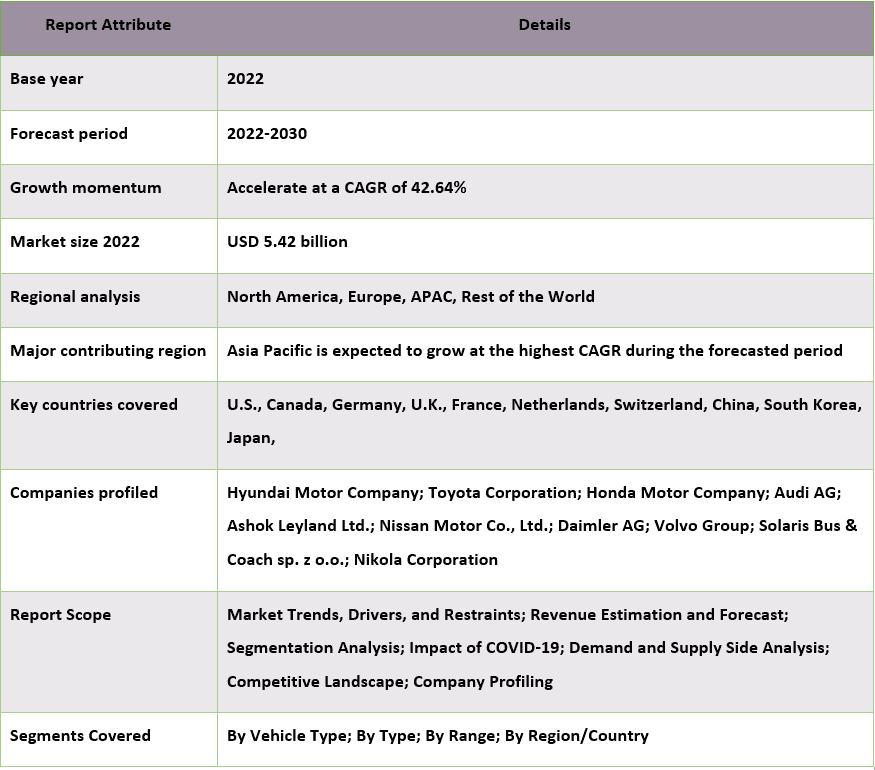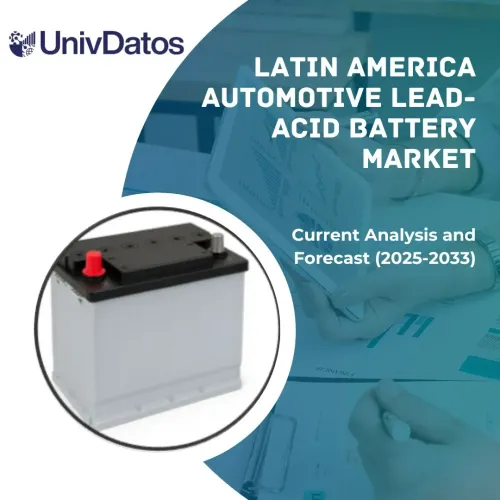- Home
- About Us
- Industry
- Services
- Reading
- Contact Us
Hydrogen Fuel Cell Electric Vehicle Market: Current Analysis and Forecast (2023-2030)
Emphasis on Vehicle Type (Passenger Vehicle, Commercial Vehicle); Type (Proton Exchange Membrane, Solid Oxide Fuel Cell, Phosphoric Acid Fuel Cell); Range (Short, Long); and Region/Country

The hydrogen fuel cell electric vehicle market is expected to grow at a strong CAGR of around 42.64% during the forecast period owing to the stringent carbon emission norms & rising adoption of zero-emission vehicles. The increasing global commitment to addressing climate change and reducing greenhouse gas emissions has propelled the adoption of zero-emission vehicles. Strict carbon emission policies imposed by governments worldwide have compelled automakers to reduce their carbon footprint. FCEVs offer a pretty efficient and environmentally friendly solution as they emit only water vapor. This makes them compliant with the most stringent emissions standards, consisting of the zero-emission car (ZEV) mandates in several nations and areas. FCEVs are gaining traction due to their capacity to decarbonize the transportation region, especially in heavy-duty applications like trucks and buses. Several countries have also implemented supportive policies, such as tax incentives, subsidies, and infrastructure development, to promote the uptake of FCEVs. Therefore, the stringent carbon emission norms and the adoption of zero-emission vehicles propelled the growth of the fuel-cell electric vehicle market in the forecast period.
Some of the major players operating in the market include Hyundai Motor Company; Toyota Corporation; Honda Motor Company; Audi AG; Ashok Leyland Ltd.; Nissan Motor Co., Ltd.; Daimler AG; Volvo Group; Solaris Bus & Coach sp. z o.o.; Nikola Corporation.
Insights Presented in the Report
“Amongst vehicle types, the passenger vehicle segment held the highest market share in 2022”
Based on the product type, the market is bifurcated into passenger vehicles and commercial vehicles. Among these passenger vehicles dominated the fuel cell electric vehicles and are expected to show the same trend in the forecast period. This technology offers numerous advantages, inclusive of zero emissions, longer driving ranges, and shorter refueling times in comparison to traditional electric-powered automobiles. As a result, FCEVs have gained more popularity within the passenger vehicle segment.
“Amongst types, the proton exchange membrane segment held the significant market share in 2022”
Based on type, the market is segmented into Proton Exchange Membrane, Solid Oxide Fuel Cell, and Phosphoric Acid Fuel Cell. Among these, Proton Exchange Membrane has a high market share in 2022 and will dominate during the forecast period. This is due to PEM being considered the most efficient with high energy conversion efficiency, which provides better mileage and longer driving ranges for FCEVs. Moreover, PEM fuel cells can quickly start and ramp up power production, making them suitable for automotive applications.
“Asia Pacific dominated the hydrogen fuel cell electric vehicle market in 2022”
The Asia Pacific region is projected to dominate the forecast period as the region has the highest number of automotive manufacturers and production units that cater to the demand for hydrogen fuel cell electric vehicles. The foremost factors attributed to the boom of the market are the increasing favorable government policies, technological advancements, investment by governments and private players, and economic growth. Further on, the region is the world’s biggest automobile market, and governments in many countries, including China, Japan, and South Korea, have been actively promoting the adoption of fuel-cell electric vehicles to reduce pollution and carbon emissions by providing rebates on cars and trucks. For instance, in 2023, in South Korea, the purchase of a new passenger car will qualify for government support of 22.5m won ($18,000) with some states adding local subsidies on top — Busan and Incheon are each offering top-ups of up to 33.5m won ($27,500), and purchased trucks and buses qualify for 21m-26m won ($17,000-$21,000) of subsidies and garbage trucks for 72m won ($59,000. Therefore, the persistent government support from countries to make FCEVs affordable and easily accessible to consumers is catering to the demand for fuel-cell electric vehicles in the region. As China continues to invest in the development of hydrogen refueling stations and fuel cell technology, the adoption and production of FCEVs will continue to rise in the years to come. Moreover, the Chinese government also provides incentives and rebates on fuel-cell electric vehicles for mass adoption. For instance, the government provides a purchase subsidy of up to USD 4500 on FCEVs, an exemption from tax, and vehicle registration tax. Moreover, The Japanese government strongly supports FCEV development and adoption. They offer incentives like subsidies and tax breaks to incentivize consumers to purchase FCEVs. Furthermore, they’ve made significant investments in hydrogen infrastructure, including refueling stations, to tackle the limited refueling options challenge. For instance, in June 2023, the Japanese government announced a new investment plan of USD 107 billion over the next 15 years to support the development and deployment of FCEVs. Moreover, the Japanese government provides subsidies of up to USD 27000 depending upon the model for the purchase of FCEVs.
Hydrogen Fuel Cell Electric Vehicle Market Report Coverage

Reasons to buy this report:
- The study includes market sizing and forecasting analysis validated by authenticated key industry experts.
- The report presents a quick review of overall industry performance at one glance.
- The report covers an in-depth analysis of prominent industry peers with a primary focus on key business financials, product portfolios, expansion strategies, and recent developments.
- Detailed examination of drivers, restraints, key trends, and opportunities prevailing in the industry.
- The study comprehensively covers the market across different segments.
- Deep dive regional level analysis of the industry.
Customization Options:
The global hydrogen fuel cell electric vehicle market can further be customized as per the requirement or any other market segment. Besides this, UMI understands that you may have your own business needs, hence feel free to connect with us to get a report that completely suits your requirements.
Table of Content
Research Methodology for the Hydrogen Fuel Cell Electric Vehicle Market Analysis (2023-2030)
Analyzing the historical market, estimating the current market, and forecasting the future market of the global hydrogen fuel cell electric vehicle market were the three major steps undertaken to create and analyze the adoption of hydrogen fuel cell electric vehicles in major regions globally. Exhaustive secondary research was conducted to collect the historical market numbers and estimate the current market size. Secondly, to validate these insights, numerous findings and assumptions were taken into consideration. Moreover, exhaustive primary interviews were also conducted, with industry experts across the value chain of the global hydrogen fuel cell electric vehicle market. Post assumption and validation of market numbers through primary interviews, we employed a top-down/bottom-up approach to forecasting the complete market size. Thereafter, market breakdown and data triangulation methods were adopted to estimate and analyze the market size of segments and sub-segments of the industry pertains to. Detailed methodology is explained below:
Analysis of Historical Market Size
Step 1: In-Depth Study of Secondary Sources:
Detail secondary study was conducted to obtain the historical market size of the hydrogen fuel cell electric vehicle market through company internal sources such as annual reports & financial statements, performance presentations, press releases, etc., and external sources including journals, news & articles, government publications, competitor publications, sector reports, third-party database, and other credible publications.
Step 2: Market Segmentation:
After obtaining the historical market size of the hydrogen fuel cell electric vehicle market, we conducted a detailed secondary analysis to gather historical market insights and share for different segments & sub-segments for major regions. Major segments are included in the report as vehicle type, type, and range. Further country-level analyses were conducted to evaluate the overall adoption of testing models in that region.
Step 3: Factor Analysis:
After acquiring the historical market size of different segments and sub-segments, we conducted a detailed factor analysis to estimate the current market size of the hydrogen fuel cell electric vehicle market. Further, we conducted factor analysis using dependent and independent variables such as vehicle type, type, and range of the hydrogen fuel cell electric vehicle market. A thorough analysis was conducted for demand and supply-side scenarios considering top partnerships, mergers and acquisitions, business expansion, and product launches in the hydrogen fuel cell electric vehicle market sector across the globe.
Current Market Size Estimate & Forecast
Current Market Sizing: Based on actionable insights from the above 3 steps, we arrived at the current market size, key players in the global hydrogen fuel cell electric vehicle market, and market shares of the segments. All the required percentage shares split and market breakdowns were determined using the above-mentioned secondary approach and were verified through primary interviews.
Estimation & Forecasting: For market estimation and forecast, weights were assigned to different factors including drivers & trends, restraints, and opportunities available for the stakeholders. After analyzing these factors, relevant forecasting techniques i.e., the top-down/bottom-up approach were applied to arrive at the market forecast for 2030 for different segments and sub-segments across the major markets globally. The research methodology adopted to estimate the market size encompasses:
- The industry’s market size, in terms of revenue (USD) and the adoption rate of the hydrogen fuel cell electric vehicle market across the major markets domestically
- All percentage shares, splits, and breakdowns of market segments and sub-segments
- Key players in the global hydrogen fuel cell electric vehicle market in terms of products offered. Also, the growth strategies adopted by these players to compete in the fast-growing market
Market Size and Share Validation
Primary Research: In-depth interviews were conducted with the Key Opinion Leaders (KOLs) including Top Level Executives (CXO/VPs, Sales Head, Marketing Head, Operational Head, Regional Head, Country Head, etc.) across major regions. Primary research findings were then summarized, and statistical analysis was performed to prove the stated hypothesis. Inputs from primary research were consolidated with secondary findings, hence turning information into actionable insights.
Split of Primary Participants in Different Regions

Market Engineering
The data triangulation technique was employed to complete the overall market estimation and to arrive at precise statistical numbers for each segment and sub-segment of the global hydrogen fuel cell electric vehicle market. data was split into several segments & sub-segments post studying various parameters and trends in the areas of the vehicle type, type, and range in the global hydrogen fuel cell electric vehicle market.
The main Objective of the Global Hydrogen Fuel Cell Electric Vehicle Market Study
The current & future market trends of the global hydrogen fuel cell electric vehicle market were pinpointed in the study. Investors can gain strategic insights to base their discretion for investments on the qualitative and quantitative analysis performed in the study. Current and future market trends determined the overall attractiveness of the market at a regional level, providing a platform for the industrial participant to exploit the untapped market to benefit from a first-mover advantage. Other quantitative goals of the studies include:
- Analyze the current and forecast market size of the hydrogen fuel cell electric vehicle market in terms of value (USD). Also, analyze the current and forecast market size of different segments and sub-segments
- Segments in the study include areas of the vehicle type, type, and range
- Define and analysis of the regulatory framework for the hydrogen fuel cell electric vehicle industry
- Analyze the value chain involved with the presence of various intermediaries, along with analyzing customer and competitor behaviors of the industry
- Analyze the current and forecast market size of the hydrogen fuel cell electric vehicle market for the major region
- Major countries of regions studied in the report include Asia Pacific, Europe, North America, and the Rest of the World
- Company profiles of the hydrogen fuel cell electric vehicle market and the growth strategies adopted by the market players to sustain in the fast-growing market
- Deep dive regional level analysis of the industry
Related Reports
Customers who bought this item also bought










